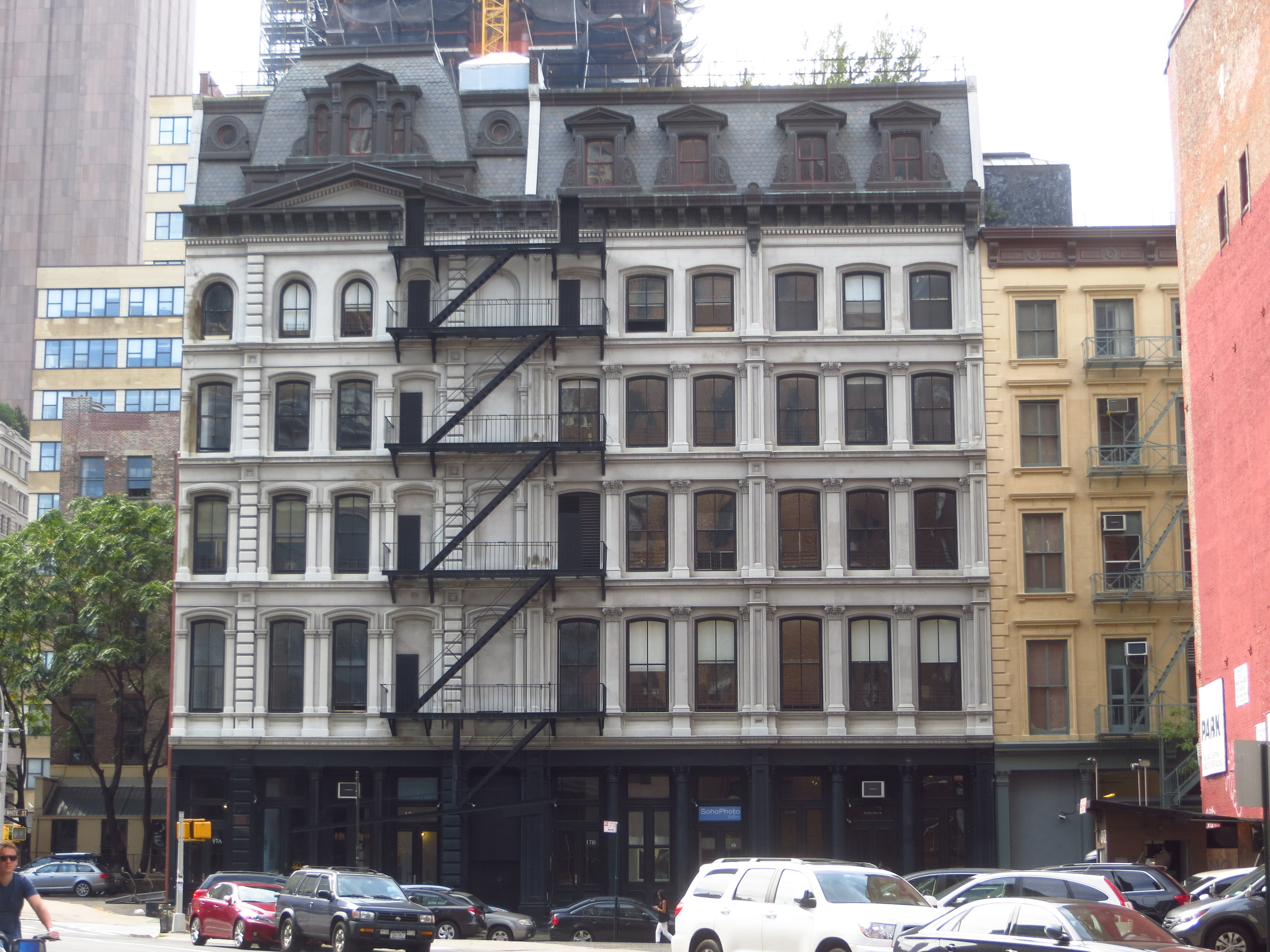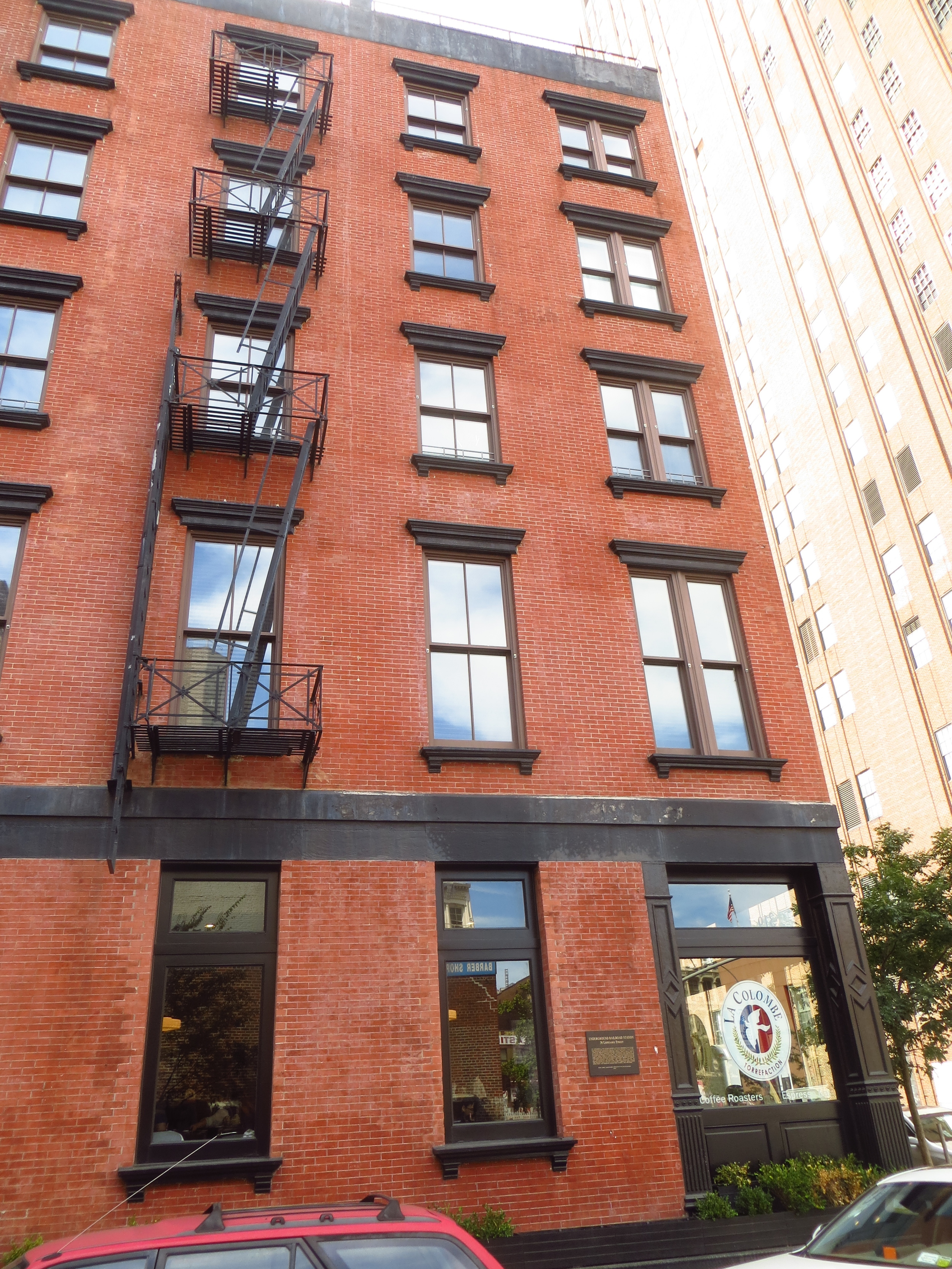TriBeCa
I took two days a few weekends apart to walk the TriBeCa neighborhood, adding 11 miles to the tally.

Two days' walk (everything inside the red line)
TriBeCa ("TRIangle BElow CAnal") is bounded by Canal St. to the north, West St. to the (you guessed it) west, Broadway to the east and Vesey St. to the south. This obviously forms more of a trapezoid than a triangle, but who's counting?
The area evolved from farmland and residential neighborhoods to a commercial center in the mid-1800s. Many of the warehouses and storefronts that were built during this period are still there today - some show their age but most have been beautifully restored.
As the manufacturing economy exited New York (and in the US in general) after WWII, the neighborhood went through a period of decline. It was famously described as a "demilitarized zone" by Harold Ramis in Ghostbusters in 1984, but by then the tide had already started to turn. The vacant commercial space had attracted artists (long on talent but short on cash) and it wasn't long before the dilapidated warehouses were renovated and converted into trendy apartments and lofts.
The World Trade Center complex makes up the southern boundary of TriBeCa and the neighborhood (along with the rest of lower Manhattan) suffered financially after 9/11 due to a general loss of vitality. Partially in response to this, Robert De Niro founded the Tribeca Film Festival in 2002 to contribute to the neighborhood's recovery and showcase lower Manhattan. It must have done the trick, because today TriBeCa is neck and neck with SoHo for the title of "Most Expensive Neighborhood in New York".

Washington St. at Hubert St.

Washington St. btw Hubert St. and Laight St.

Vestry St. btw Washington St. and Greenwich St.

Washington St. btw Vestry St. and Desbrosses St.

Desbrosses St. btw Washington St. and Greenwich St.

Vestry St. btw Hudson St. and Greenwich St.

Vestry St. btw Greenwich St. and Varick St.

Vestry St. btw Greenwich St. and Varick St.

Vestry St. btw Greenwich St. and Varick St.

Laight St. btw Greenwich St. and Varick St.

Laight St. btw Hudson St. and Greenwich St.

Laight St. btw Greenwich St. and Washington St.

Collister St. btw Hubert St. and Beach St.

Ericsson Pl. btw Hudson St. and Varick St.

Ericsson Pl. btw Hudson St. and Varick St.

York St. btw St. Johns Ln. and 6th Ave.

Lispenard St. btw 6th Ave. and Church St.

Lispenard St. btw 6th Ave. and Church St.

Lispenard St. btw 6th Ave. and Church St.

Lispenard St. btw Church St. and Broadway

Lispenard St. btw Church St. and Broadway

Lispenard St. btw Church St. and Broadway

Lispenard St. btw Church St. and Broadway

Walker St. btw Church St. and Broadway

Walker St. btw Church St. and Broadway

N Moore St. btw W Broadway and Varick St.

N Moore St. btw W Broadway and Varick St.

N Moore St. btw W Broadway and Varick St.

N Moore St. btw W Broadway and Varick St.

N Moore St. btw Hudson St. and Greenwich St.

N Moore St. btw Varick St. and Hudson St.

Harrison St. btw West St. and Greenwich St.

Harrison St. btw Greenwich St. and Hudson St.

Franklin St. btw Hudson St. and Varick St.

Franklin St. btw Varick St. and W Broadway St.

Franklin Pl. btw White St. and Franklin St.

White St. btw Broadway and Church St.

Leonard St. btw Varick St. and Hudson St.

Worth St. btw Church St. and W Broadway

Worth St. btw W Broadway and Hudson St.

Jay St. btw Hudson St. and Greenwich St.

Staple St. btw. Jay St. and Harrison St.

Thomas St. btw. Church St. and Broadway

Duane St. btw. Greenwich St. and Hudson St.

Duane St. btw. Church St. and Broadway

Duane St. btw. Church St. and W Broadway

Reade St. btw. W Broadway and Church St.

Duane St. btw. Church St. and W Broadway

Duane St. btw. Hudson and W Broadway

Duane St. btw. Church St. and W Broadway

Warren St. btw. River Terrace and North End Ave.

Warren St. btw. North End Ave. and West St.

Warren St. btw. W Broadway and Church St.

Warren St. btw W Broadway and Church St.

Warren St. btw. Church St. and Broadway

Murray St. btw North End Ave. and West St.

Rockefeller Park at River Terrace

Rockefeller Park at River Terrace

River Terrace at North End Ave.

River Terrace at North End Ave.

North End Ave. at Chambers St.

Rockefeller Park at River Terrace and Chambers St.

Rockefeller Park at River Terrace and Chambers St.

River Terrace at Murray St.

Park Pl. btw Broadway and Church

Park Pl. btw Broadway and Church

Vesey St. btw North End Ave. and West St.

Vesey St. btw North End Ave. and West St.

North End Ave. (southern terminus)

Vesey St. btw Church St. and Broadway

Greenwich St. btw Vesey St. and Barclay St.






































































